
Today’s readings made me think about an issue I personally grappled with since I started teaching in the Fall semester of 2020: the notion that a lot of my/our success as educators depends on my/our ability to facilitate student’s engagement. This has been particularly challenging for me because I had never taught before, and also because I had to learn on the go not only how to be a teacher, but also how to teach online when most of my own experience as a student had taken place in person.
But my situation is far from unique. In “Connectivism: A Learning Theory for the Digital Age,” George Siemens outlines how educational institutions and workplaces, students, teachers and workers alike, have had to transform the way they learn, teach and prepare for the workforce in a world where people’s ability to learn new skills is more important than the skills they already possess. If what we teach students might be irrelevant or outdated in just a few years, Siemens suggests, it is our capacity to teach them how to learn what will help them thrive, more than the pieces of information we can provide them.
The question here turns from what we teach, what content we tell our students to memorize and critically engage with, to how we present that information in a way that empowers students to actively participate rather than passively receive data and information. This shift from the “what” to the “how” also entails a big question about how we intentionally incorporate technology into our classrooms, especially now that we are teaching online. How can we use Zoom, Blackboard, emails, search engines, online translators, Google forms, social media networks, computers, mobile devices, screens, microphones, to empower our students to use their voices and minds in liberating ways rather than oppressive ones? I think this is particularly important for the student population we work with, the CUNY students who for example feel more comfortable not turning their cameras or microphones on while in class, and therefore cannot participate in small group activities or in class discussions, because they live with elder relatives or small children that require their attention or make noise while they are in class.
One of the game-changing decisions I have made in my class this semester was to open up breakout rooms for students to work together in every session, as opposed to what I used to do last semester when I would assign activities for them to work individually. I now let them talk and interact with each other for at least 5 minutes three times per class, before we check the answers for grammar or sentence formation exercises. And I am happy to provide them with that online space for them to engage and talk, even if they are not necessarily talking about my class content exclusively. In the midst of a global pandemic and socially distanced life, I bet they appreciate that space. If they are not learning Spanish grammar, at least they will practice how to be social.
According to Siemens (2004), “Connectivism is the integration of principles explored by chaos, network, and complexity and self-organization theories. Learning is a process that occurs within nebulous environments of shifting core elements – not entirely under the control of the individual. Learning (defined as actionable knowledge) can reside outside of ourselves (within an organization or a database), is focused on connecting specialized information sets, and the connections that enable us to learn more are more important than our current state of knowing.” I did not know the meaning of “connectivism” as stated by Siemens before reading his texts, and certainly not when I made the decision to prioritize student collaboration, but this semester my students’ engagement has increased. Some of them have even asked for additional homework assignments.
I’d like to end my provocation by inviting you all to think of what you can do to transition from traditional (online) teaching/learning models, those that have largely shaped us as students, to other models that foster engagement and personal network formations as goals rather than tools. What pedagogical opportunities and what challenges emerge while trying to use the technologies our institutions have provided us? How can we effectively transition from information-based teaching to more experiential and community-oriented learning?

